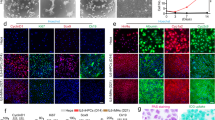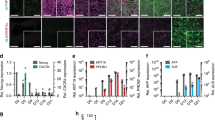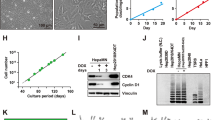Abstract
Hepatocytes have a critical role in metabolism, but their study is limited by the inability to expand primary hepatocytes in vitro while maintaining proliferative capacity and metabolic function. Here we describe the oncostatin M (OSM)-dependent expansion of primary human hepatocytes by low expression of the human papilloma virus (HPV) genes E6 and E7 coupled with inhibition of epithelial-to-mesenchymal transition. We show that E6 and E7 expression upregulates the OSM receptor gp130 and that OSM stimulation induces hepatocytes to expand for up to 40 population doublings, producing 1013 to 1016 cells from a single human hepatocyte isolate. OSM removal induces differentiation into metabolically functional, polarized hepatocytes with functional bile canaliculi. Differentiated hepatocytes show transcriptional and toxicity profiles and cytochrome P450 induction similar to those of primary human hepatocytes. Replication and infectivity of hepatitis C virus (HCV) in differentiated hepatocytes are similar to those of Huh7.5.1 human hepatoma cells. These results offer a means of expanding human hepatocytes of different genetic backgrounds for research, clinical applications and pharmaceutical development.
This is a preview of subscription content, access via your institution
Access options
Subscribe to this journal
Receive 12 print issues and online access
$209.00 per year
only $17.42 per issue
Buy this article
- Purchase on Springer Link
- Instant access to full article PDF
Prices may be subject to local taxes which are calculated during checkout





Similar content being viewed by others
References
Kaplowitz, N. Idiosyncratic drug hepatotoxicity. Nat. Rev. Drug Discov. 4, 489–499 (2005).
Kidambi, S. et al. Oxygen-mediated enhancement of primary hepatocyte metabolism, functional polarization, gene expression, and drug clearance. Proc. Natl. Acad. Sci. USA 106, 15714–15719 (2009).
Khetani, S.R. & Bhatia, S.N. Microscale culture of human liver cells for drug development. Nat. Biotechnol. 26, 120–126 (2008).
Nahmias, Y., Berthiaume, F. & Yarmush, M. in Tissue Engineering II vol. 103 (eds. Lee, K. & Kaplan, D.) 309–329 (Springer, 2007).
Yamamoto, N., Imazato, K. & Masumoto, A. Growth stimulation of adult rat hepatocytes in a primary culture by soluble factor(s) secreted from nonparenchymal liver cell. Cell Struct. Funct. 14, 217–229 (1989).
Shimaoka, S., Nakamura, T. & Ichihara, A. Stimulation of growth of primary cultured adult rat hepatocytes without growth factors by coculture with nonparenchymal liver cells. Exp. Cell Res. 172, 228–242 (1987).
Shan, J. et al. Identification of small molecules for human hepatocyte expansion and iPS differentiation. Nat. Chem. Biol. 9, 514–520 (2013).
Schippers, I.J. et al. Immortalized human hepatocytes as a tool for the study of hepatocytic (de-)differentiation. Cell Biol. Toxicol. 13, 375–386 (1997).
Tsuruga, Y. et al. Establishment of immortalized human hepatocytes by introduction of HPV16 E6/E7 and hTERT as cell sources for liver cell-based therapy. Cell Transplant. 17, 1083–1094 (2008).
Sivertsson, L. et al. CYP3A4 catalytic activity is induced in confluent Huh7 hepatoma cells. Drug Metab. Dispos. 38, 995–1002 (2010).
Wilkening, S., Stahl, F. & Bader, A. Comparison of primary human hepatocytes and hepatoma cell line HepG2 with regard to their biotransformation properties. Drug Metab. Dispos. 31, 1035–1042 (2003).
Nyberg, S.L. et al. Primary hepatocytes outperform Hep G2 cells as the source of biotransformation functions in a bioartificial liver. Ann. Surg. 220, 59–67 (1994).
Guillouzo, A. et al. The human hepatoma HepaRG cells: a highly differentiated model for studies of liver metabolism and toxicity of xenobiotics. Chem. Biol. Interact. 168, 66–73 (2007).
Avior, Y. et al. Microbial-derived lithocholic acid and vitamin K2 drive the metabolic maturation of pluripotent stem cells–derived and fetal hepatocytes. Hepatology 62, 265–278 (2015).
Takebe, T. et al. Vascularized and functional human liver from an iPSC-derived organ bud transplant. Nature 499, 481–484 (2013).
Si-Tayeb, K. et al. Highly efficient generation of human hepatocyte-like cells from induced pluripotent stem cells. Hepatology 51, 297–305 (2010).
Szkolnicka, D. et al. Accurate prediction of drug-induced liver injury using stem cell-derived populations. Stem Cells Transl. Med. 3, 141–148 (2014).
Parent, R., Marion, M.-J., Furio, L., Trépo, C. & Petit, M.-A. Origin and characterization of a human bipotent liver progenitor cell line. Gastroenterology 126, 1147–1156 (2004).
Anthérieu, S. et al. Stable expression, activity, and inducibility of cytochromes P450 in differentiated HepaRG cells. Drug Metab. Dispos. 38, 516–525 (2010).
Gerets, H.H. et al. Characterization of primary human hepatocytes, HepG2 cells, and HepaRG cells at the mRNA level and CYP activity in response to inducers and their predictivity for the detection of human hepatotoxins. Cell Biol. Toxicol. 28, 69–87 (2012).
Clayton, R.F. et al. Liver cell lines for the study of hepatocyte functions and immunological response. Liver Int. 25, 389–402 (2005).
Burkard, A. et al. Generation of proliferating human hepatocytes using Upcyte technology: characterisation and applications in induction and cytotoxicity assays. Xenobiotica 42, 939–956 (2012).
Moody, C.A. & Laimins, L.A. Human papillomavirus oncoproteins: pathways to transformation. Nat. Rev. Cancer 10, 550–560 (2010).
Ishiji, T. Molecular mechanism of carcinogenesis by human papillomavirus-16. J. Dermatol. 27, 73–86 (2000).
Aly, H.H. et al. Serum-derived hepatitis C virus infectivity in interferon regulatory factor-7-suppressed human primary hepatocytes. J. Hepatol. 46, 26–36 (2007).
Tsuruga, Y. et al. Establishment of immortalized human hepatocytes by introduction of HPV16 E6/E7 and hTERT as cell sources for liver cell-based therapy. Cell Transplant. 17, 1083–1094 (2008).
Pollack, V. et al. Oncostatin M-induced effects on EMT in human proximal tubular cells: differential role of ERK signaling. Am. J. Physiol. Renal Physiol. 293, F1714–F1726 (2007).
Nakamura, K., Nonaka, H., Saito, H., Tanaka, M. & Miyajima, A. Hepatocyte proliferation and tissue remodeling is impaired after liver injury in oncostatin M receptor knockout mice. Hepatology 39, 635–644 (2004).
Dierssen, U. et al. Molecular dissection of gp130-dependent pathways in hepatocytes during liver regeneration. J. Biol. Chem. 283, 9886–9895 (2008).
Bauknecht, T. et al. Response to IL-6 of HPV-18 cervical carcinoma cell lines. Virology 258, 344–354 (1999).
Yu, H., Lee, H., Herrmann, A., Buettner, R. & Jove, R. Revisiting STAT3 signalling in cancer: new and unexpected biological functions. Nat. Rev. Cancer 14, 736–746 (2014).
Duncan, A.W. et al. The ploidy conveyor of mature hepatocytes as a source of genetic variation. Nature 467, 707–710 (2010).
Duncan, A.W. et al. Frequent aneuploidy among normal human hepatocytes. Gastroenterology 142, 25–28 (2012).
Westerink, W.M. & Schoonen, W.G. Cytochrome P450 enzyme levels in HepG2 cells and cryopreserved primary human hepatocytes and their induction in HepG2 cells. Toxicol. In Vitro 21, 1581–1591 (2007).
Ploss, A. et al. Persistent hepatitis C virus infection in microscale primary human hepatocyte cultures. Proc. Natl. Acad. Sci. USA 107, 3141–3145 (2010).
Ndongo-Thiam, N. et al. Long-term propagation of serum hepatitis C virus (HCV) with production of enveloped HCV particles in human HepaRG hepatocytes. Hepatology 54, 406–417 (2011).
Schaller, T. et al. Analysis of hepatitis C virus superinfection exclusion by using novel fluorochrome gene-tagged viral genomes. J. Virol. 81, 4591–4603 (2007).
Zhong, J. et al. Robust hepatitis C virus infection in vitro. Proc. Natl. Acad. Sci. USA 102, 9294–9299 (2005).
Nevo-Yassaf, I. et al. Role for TBC1D20 and Rab1 in hepatitis C virus replication via interaction with lipid droplet-bound nonstructural protein 5A. J. Virol. 86, 6491–6502 (2012).
Miyanari, Y. et al. The lipid droplet is an important organelle for hepatitis C virus production. Nat. Cell Biol. 9, 1089–1097 (2007).
Mitaka, T. The current status of primary hepatocyte culture. Int. J. Exp. Pathol. 79, 393–409 (1998).
Runge, D., Michalopoulos, G.K., Strom, S.C. & Runge, D.M. Recent advances in human hepatocyte culture systems. Biochem. Biophys. Res. Commun. 274, 1–3 (2000).
Klochendler, A. et al. A transgenic mouse marking live replicating cells reveals in vivo transcriptional program of proliferation. Dev. Cell 23, 681–690 (2012).
Trautwein, C. et al. C/EBP-β/LAP controls down-regulation of albumin gene transcription during liver regeneration. J. Biol. Chem. 271, 22262–22270 (1996).
Münger, K., Phelps, W.C., Bubb, V., Howley, P.M. & Schlegel, R. The E6 and E7 genes of the human papillomavirus type 16 together are necessary and sufficient for transformation of primary human keratinocytes. J. Virol. 63, 4417–4421 (1989).
Arlotto, M.P., Trant, J.M. & Estabrook, R.W. Measurement of steroid hydroxylation reactions by high-performance liquid chromatography as indicator of P450 identity and function. Methods Enzymol. 206, 454–462 (1991).
Behnia, K. et al. Xenobiotic metabolism by cultured primary porcine hepatocytes. Tissue Eng. 6, 467–479 (2000).
Donato, M.T., Jimenez, N., Castell, J.V. & Gomez-Lechon, M.J. Fluorescence-based assays for screening nine cytochrome P450 (P450) activities in intact cells expressing individual human P450 enzymes. Drug Metab. Dispos. 32, 699–706 (2004).
Ducy, P. et al. Leptin inhibits bone formation through a hypothalamic relay: a central control of bone mass. Cell 100, 197–207 (2000).
Ben-David, U. et al. Aneuploidy induces profound changes in gene expression, proliferation and tumorigenicity of human pluripotent stem cells. Nat. Commun. 5, 4825 (2014).
Ekins, S. et al. Quantitative differences in phase I and II metabolism between rat precision-cut liver slices and isolated hepatocytes. Drug Metab. Dispos. 23, 1274–1279 (1995).
Habig, W.H. et al. The identity of glutathione-S-transferase B with ligandin, a major binding protein of liver. Proc. Natl. Acad. Sci. USA 71, 3879–3882 (1974).
Acknowledgements
The authors wish to thank D. Kitsberg, E. Flashner and T. Golan-Lev for technical support. We also wish to thank M. Vinken, V. Rogiers, N. Benvenisty and S. Bhatia for their comments and suggestions. This work was funded by the Förderprogram Biotechnologie Baden-Würtenberg (project 720.830-4-03; S.H., S.D.R., A.N. and J.B.), European Research Council Starting Grant TMIHCV (project 242699; G.L., D.B., M.C. and Y.N.), and HeMiBio: a jointly funded consortium by the European Commission and Cosmetics Europe, as part of the SEURAT-1 cluster (project HEALTH-F5-2010-266777).
Author information
Authors and Affiliations
Contributions
G.L., S.H., S.D.R., A.N. and Y.N. designed and performed experiments and analyzed data; D.B., M.C., E.S. and O.S. provided materials, technical support and conceptual advice; J.B. and Y.N., administered experiments and wrote the paper.
Corresponding author
Ethics declarations
Competing interests
Y.N., G.L., A.N., S.H. and J.B. submitted a patent application on the method described in this work.
Integrated supplementary information
Supplementary Figure 1 Characterization of genetically induced proliferation in human hepatocytes.
(A) Western blot analysis for p53 expression in HeLa (negative control) and MDA-MB-231 cell lines (positive control), source cryopreserved human hepatocytes as well as the resulting E6 and E7 transduced hepatocytes (E6/E7LOW). E6/E7LOW hepatocytes retained p53 expression in the presence or absence of OSM, similar to their source hepatocytes and the MDA-MB-231 control, while HeLa cells transformed by infection do not. (B) OSM signaling activates the HPV noncoding upstream regulatory region (URR) in HepG2 cells, suggesting a viral feedback loop (Fig. 1A). To test whether OSM treatment up-regulates E6 and E7 in transduced hepatocytes lacking the URR, we compared the expression of E6 and E7 in transduced hepatocytes and HepG2 cells in the presence or absence of OSM. OSM stimulation of E6/E7LOW hepatocytes does not increase E6 and E7 expression (p=0.19, n=3), while HepG2 cells containing dormant URR show up-regulation of E6 and E7, with a 2-fold induction (p=0.008, n=3). (C) Growth curves of transduced hepatocytes exposed to 10 ng/mL HGF, 20 ng/mL EGF, or 10 ng/mL OSM. OSM stimulation resulted in rapid expansion, with 34±2 hours doubling time. EGF and HGF stimulation was not different from control. (D) Growth curves of transduced hepatocytes exposed to EGF or HGF during OSM induced proliferation. Both EGF and HGF increased proliferation over OSM alone, resulting in 32±1 hour doubling time, which was not significantly different from OSM alone over the given time frame. (E) OSM-induced expansion of E6/E7LOW and E6/E7HIGH hepatocytes promotes the acquisition of a fibroblastoid phenotype (Fig. 1E). To demonstrate the cells are hepatocytes that underwent EMT we carried out a qRT-PCR analysis showing the cells express epithelial specific EpCAM and are negative to mesenchyme intermediate filament vimentin. Cells also expressed low levels of albumin and AFP, marking a hepatocyte origin. Gene expression analysis presented in log scale. Values are normalized to human fibroblasts. (F) To evaluate whether transduced hepatocytes express the fetal marker CYP3A7 we compared expression levels by qRT-PCR of proliferating (E6/E7LOW+OSM) and differentiated (E6/E7LOW) hepatocytes, primary hepatocytes, HepG2, and fetal hepatocytes. Differentiated transduced hepatocytes express CYP3A7 at 32% of primary hepatocyte levels, and three orders of magnitude lower than fetal hepatocytes, showing transduced hepatocytes do not up-regulate fetal CYP3A7 (n=3). (G) BrdU labeling of OSM-stimulated hepatocytes shows 23% of the cells are proliferating at each time point. However, only 10±5% of the cells were positive for albumin (top right). In contrast, over 95±5% of differentiated cells were positive for albumin during OSM-deprivation induced differentiation when BrdU incorporation was <1% (bottom right). We note that BrdU incorporation is carried out in 1 hour while cell doubling time ranges from 33 to 49 hours, suggesting only 23% of the population replicates at each given moment. Importantly, the bi-modal albumin expression pattern mimics previously reported loss of albumin expression during liver regeneration. (H) Western blot analysis of STAT3 phosphorylation in differentiated hepatocytes (E6/E7low) and proliferating hepatocytes (E6/E7low + OSM) treated with Stattic STTC).
Supplementary Figure 2 CYP450 activity in genetically induced primary human hepatocytes.
CYP450 activity of differentiated hepatocytes (donor 653) compared with HepG2 cells and cryopreserved primary human hepatocytes. Permutation test shows that CYP450 activity profile of differentiated hepatocytes is not significantly different from the profile of primary cells (p=0.44, n=5), while HepG2 activity profile was significantly higher (p=0.04, n=5).
Supplementary Figure 3 Variability between different hepatocyte donors in CYP450 expression and drug toxicity.
(A) Quantitative gene expression analysis of primary human hepatocytes and HepG2 cells compared with differentiated hepatocyte from donors 653, 422A, and 10. All three lines show comparable levels of gene expression. (B) Graph comparing the TC50 of 18 compounds (Supplementary Table 1) in differentiated hepatocytes from donors 653, 151, 10, and 422A against TC50 values for primary human hepatocytes. Toxicity was measured using the MTS assay. All donors showed an R2 correlation of 0.99 (n=3). Values presented in Log scale.
Supplementary Figure 4 Toxicity curves for differentiated and proliferating hepatocytes treated with known hepatotoxic and control compounds (donor 653).
(A) Dose dependent toxicity curves comparing day four differentiated hepatocytes (red diamonds) and proliferating hepatocytes (blue squares) treated with increasing doses of toxic and control compounds for 24 hours (n=3). To evaluate the potential of these E6/E7LOW hepatocytes to predict human response we tested 9 known hepatotoxic drugs and 3 control compounds of similar structure. We show that differentiated hepatocytes show toxic response to all 9 hepatotoxic drugs, matching the toxicological end-point in all cases including apoptosis, steatosis, and cholestasis. (B) Table comparing TC50 values obtained for proliferating E6/E7LOW hepatocytes, differentiated hepatocytes and cryopreserved primary human hepatocytes.
Supplementary information
Supplementary Text and Figures
Supplementary Figures 1–4 and Supplementary Tables 1–2 (PDF 1163 kb)
Rights and permissions
About this article
Cite this article
Levy, G., Bomze, D., Heinz, S. et al. Long-term culture and expansion of primary human hepatocytes. Nat Biotechnol 33, 1264–1271 (2015). https://doi.org/10.1038/nbt.3377
Received:
Accepted:
Published:
Issue Date:
DOI: https://doi.org/10.1038/nbt.3377
This article is cited by
-
Liver organoid culture methods
Cell & Bioscience (2023)
-
Generation of proliferating human adult hepatocytes using optimized 3D culture conditions
Scientific Reports (2021)
-
Proteomic profiling of murine biliary-derived hepatic organoids and their capacity for drug disposition, bioactivation and detoxification
Archives of Toxicology (2021)
-
Fluorescent tagging of endogenous Heme oxygenase-1 in human induced pluripotent stem cells for high content imaging of oxidative stress in various differentiated lineages
Archives of Toxicology (2021)
-
Amino acid levels determine metabolism and CYP450 function of hepatocytes and hepatoma cell lines
Nature Communications (2020)



